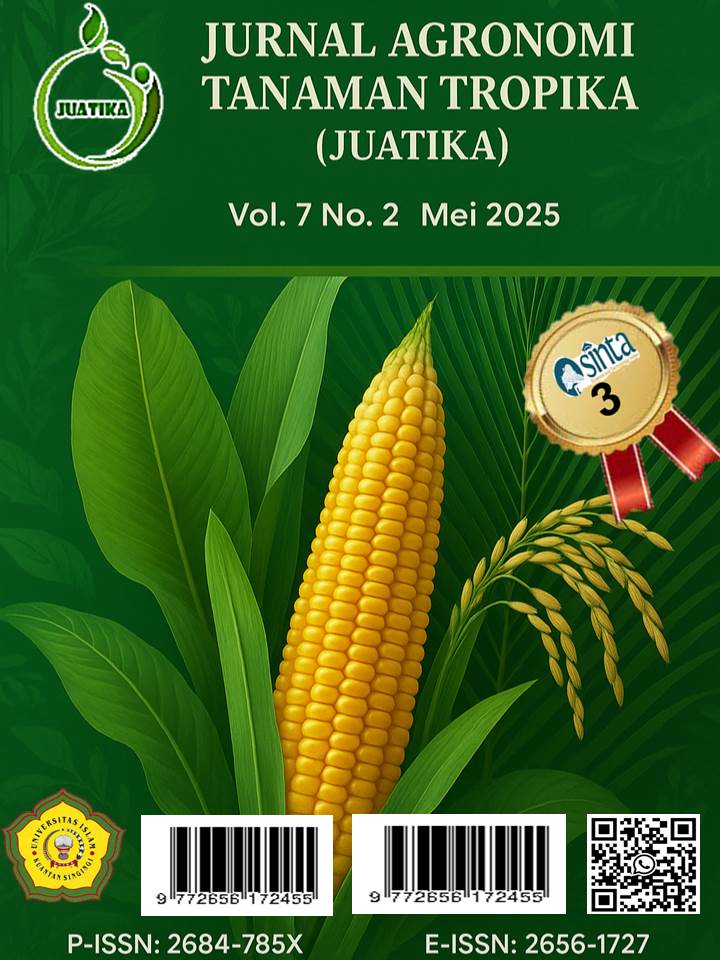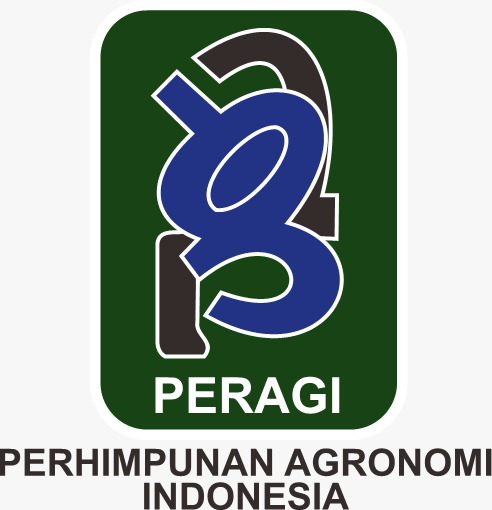Comparing the Utilization of Cocopeat and Topsoil Planting Media with Cow Manure Fertilizer on Chili Peppers' (Capsicum frutescens) Growth
Abstract
Chili pepper (Capsicum frutescens) is one of the important horticultural commodities in Indonesia, widely cultivated due to its spicy flavor and high economic value. This study aims to compare the effectiveness of various planting media and fertilizers in promoting the environmentally friendly growth of chili pepper plants. The study employed a Factorial Randomized Block Design (RAK) with treatments including: Control (without cow manure), 2 kg of cocopeat and 1 ounce of cow manure, 2 kg of cocopeat and 1.5 ounces of cow manure, 2 kg of cocopeat and 2 ounces of cow manure, 2 kg of soil and 1 ounce of cow manure, 2 kg of soil and 1.5 ounces of cow manure, and 2 kg of soil and 2 ounces of cow manure. Data analysis was conducted using ANOVA and BNT post-hoc tests. The results showed that the planting media did not significantly affect plant height or the number of leaves, though variations in values were observed across treatments. In cocopeat media, the treatment of 2 kg of cocopeat and 1.5 ounces of cow manure resulted in the highest plant height at week 4, measuring 30.03 cm, followed by 2 kg of cocopeat and 1 ounce of cow manure (29.23 cm), 2 kg of cocopeat and 2 ounces of cow manure (29.20 cm), and the control treatment (28.46 cm). The highest number of leaves was also found in the 2 kg of cocopeat and 1.5 ounces of cow manure treatment, with 16.66 leaves, although in the second week, the control treatment recorded only 6.33 leaves. In soil media, the 2 kg of soil and 2 ounces of cow manure treatment produced 17.66 leaves, with variations in the second week noted between the cow manure treatments and the control group.
Downloads
References
Adolph, R. (2016). Pengaruh jenis media tanam terhadap pertumbuhan vegetatif tanaman cabai rawit (Capsicum frutescens L.), 2(2), 1–23.
Agustine, L. (2023). Sosialisasi pembuatan pupuk organik kotoran sapi, 4(4), 4340–4343.
Banu, L. S. (2020). Review: Pemanfaatan limbah kulit bawang merah dan ampas kelapa sebagai pupuk organik terhadap pertumbuhan beberapa tanaman sayuran. Jurnal Ilmiah Respati, 11(2), 148–155. https://doi.org/10.52643/jir.v11i2.1125
Farid, M. (2020). Pendampingan pengelolaan limbah kotoran sapi menjadi pupuk organik kepada peternak sapi di Desa Pandanarum Kecamatan Tempeh Lumajang. Khidmatuna: Jurnal Pengabdian Masyarakat, 1(1), 59. https://doi.org/10.54471/khidmatuna.v1i1.998
Harahap, P. (2022). Kajian produksi tanaman cabai rawit (Capsicum frutescens L.) dengan media tumbuh cocopeat dalam pot. Jurnal LPPM, 12(4). http://jurnal.ugn.ac.id/index.php/jurnallppm/article/view/946
Kurniawan, E., Ginting, Z., & Nurjannah, P. (2017). Pemanfaatan urine kambing pada pembuatan pupuk organik cair terhadap kualitas unsur hara makro (NPK). Jurnal UMJ, 1(2), 1–10. http://jurnal.umj.ac.id/index.php/semnastek
Kusumawati, R. D., Hariyono, D., & Aini, N. (2016). Pengaruh komposisi media tanam dan interval pemberian air sampai dengan kapasitas lapang terhadap produksi tanaman cabai rawit (Capsicum frutescens L.). Plantropica: Journal of Agricultural Science, 1(2), 64–71.
Nasution, Y., & Tammin, T. P. (2022). Pengaruh media tanam sabut kelapa (cocopeat) dan pupuk kandang terhadap pertumbuhan dan produksi tanaman cabai rawit (Capsicum frutescens L.). Jurnal Ilmiah Hijau Cendekia, 7(1), 41. https://doi.org/10.32503/hijau.v7i1.2257
Ramli, R., Nurcholis, J., & Ramadhani, A. (2023). Efektivitas pengaplikasian air kelapa dan berbagai jenis media tanam terhadap produksi microgreen tanaman sawi (Brassica juncea L.). Jurnal Agrisistem, 19(1), 32–39. https://doi.org/10.52625/j-agr.v19i1.270
Sari, I. A., Suprapto, A., & Jannah, E. N. (2023). Pengaruh kombinasi media tanam pasir pantai, tanah liat, dan pupuk kandang terhadap tanaman cabai rawit (Capsicum frutescens L.) varietas Dewa. Seminar Nasional Dies Natalis ke-47 UNS Tahun 2023, 7(1), 359–369.
Siregar, M. (2020). Pengaruh aplikasi beberapa media tanam terhadap pertumbuhan dan produksi bawang merah dengan teknologi akuaponik. Agrium, 23(1), 46–51. https://doi.org/10.30596/agrium.v21i3.2456
Sukasana, I. W., Agung, A., Putra, G., Apriastuti, P. E. K. A., Ayu, I. G., & Utami, S. (2024). Pertumbuhan dan hasil cabai rawit (Capsicum frutescens L.) pada dosis Trichoderma sp. dan pupuk organik petroganik. [Nama jurnal tidak tercantum], 503–509.
Widiarta, I. P. O., Mayun, I. A., & Astiningsih, A. A. M. (2021). Pengaruh jenis media tanam terhadap pertumbuhan benih cabai rawit (Capsicum frutescens L.). Jurnal Agroekoteknologi, 10(2), 173. https://ojs.unud.ac.id/index.php/jat
Yahya, N., Serdani, A. D., Puspitorini, P., & Widiatmanta, J. (2023). Pengaruh jenis media tanam dan pemberian mikoriza terhadap pertumbuhan dan hasil tanaman cabai rawit (Capsicum frutescens L.). Prosiding: Seminar Nasional Ekonomi dan Teknologi, 49–58. https://doi.org/10.24929/prosd.v0i0.2793
Copyright (c) 2025 Dimas Agung Arya, Hilwa Walida, Badrul Ainy Dalimunthe, Yusmaidar Sepriani

This work is licensed under a Creative Commons Attribution 4.0 International License.
Authors who publish with Jurnal Agronomi Tanaman Tropika (JUATIKA) agree to the following terms:
Authors retain copyright and grant the Jurnal Agronomi Tanaman Tropika (JUATIKA) right of first publication with the work simultaneously licensed under a Creative Commons Attribution License (CC BY 4.0) that allows others to share (copy and redistribute the material in any medium or format) and adapt (remix, transform, and build upon the material for any purpose, even commercially) with an acknowledgment of the work's authorship and initial publication in Jurnal Agronomi Tanaman Tropika (JUATIKA).
Authors are able to enter into separate, additional contractual arrangements for the non-exclusive distribution of the journal's published version of the work (e.g., post it to an institutional repository or publish it in a book), with an acknowledgment of its initial publication in Jurnal Agronomi Tanaman Tropika (JUATIKA). Authors are permitted and encouraged to post their work online (e.g., in institutional repositories or on their website) prior to and during the submission process, as it can lead to productive exchanges, as well as earlier and greater citation of published work.







 More Information
More Information



